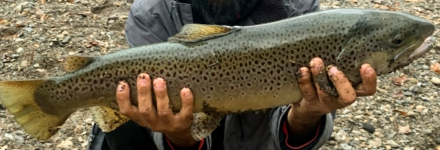Similar situation near me. Two years ago I temped the river in the upper 80's during the heat of summer. I'd love to RFID tag some and find out exactly where they're going during the summer, but I have a pretty good idea. In this case, I'm about 80% sure they're going to groundwater upwellings IN the river. Probably a mix of moving great distances for some and others hugging thermal refuge within the river in nearby upwellings.
Just as a reminder, salmonids can and do move great distances (123 miles for one fish in the following study) over fairly short time periods. Even the stocked ones:
https://www.fishandboat.com/Fish/Fisheries/TroutPlan/Documents/trout_movement.pdf
An interesting site from MT TU:
https://montanatu.org/troutmigration/
Redbands;
https://www.beaverinstitute.org/wp-content/uploads/2017/08/MontanaTroutMovement.pdf
I know I've posted it before, but Shannon White's research in the Loyalsock turned up some interesting results (max distance traveled by an individual was 13km/8 miles.
https://doi.org/10.1111/fwb.13637
MD DNR:
https://dnr.maryland.gov/fisheries/Documents/Telemetry_Study.pdf
Anecdotally, A friend caught a brown (with very distinguishing physical characteristics) a few years ago in a tributary to a larger river and caught the same fish the following weekend in another tributary some 20+ river miles away (down one tributary, up a large river, and up another tributary). Spawning related.
Neither here nor there, but all of this reinforces the issue with managing the Commonwealth's waters by "sections". Time of year, species, baseflow conditions and even angling pressure play a role in salmonid movement.





